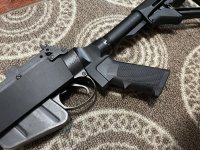If I put my disassembled Remington-Lee M1879 beside my MLM I*, the differences are very small. On the Rem-Lee, the sear lugs actually were recoil lugs and fit into a recess in the one-piece stock that took the recoil. I think if I were going to try and really improve the rifle I'd go with the one-piece stock. Some think the two-piece stock for the LE originated with a desire to use up Martini blanks. I've never seen any period government explanation of why they took this route.
But, since they did, it's worth considering what was learned over the next 50 years about accuracy and functional issues. When a LE is fired the stresses tend to reduce the angle between butt and barreled action, which places a compressive stress on the forend. This isn't "recoil"-that is totally taken up by the butt-socket pressing against the butt and your shoulder. The barrels are thin and whippy and the bedding changed radically through time. Long Lees pretty much had full-length bedding of their heavier barrel. The Smle's had the inner band and, eventually, the spring-stud in the nosecap. The No. 4 was simpler, with float between reinforce and forend tip where up-pressure was definitely necessary for best accuracy. Target shooters have tried many tricks, but nothing was ever found that would dramatically improve accuracy over well set-up standard bedding. MOA accuracy is not hard to achieve. The forend acts as a long wooden spring and replacing all or part of it with much stiffer metal may not work with the barrels natural "harmonics."
Getting back to the rear end, wood is preferable for the application as it compresses enough to allow a perfect fit at the draws to be achieved. Even when using copper blocks (as the Aussies did) the metal is soft enough to form itself to the sear lugs as the forend is forced on (and then held in place by the triggerguard). To machine a hard metal for perfect fit will be interesting- and keep in mind that perfect fit at the draws must be achieved simultaneously with perfect fit at the barrel reinforce and at the forend tip.
To me, this kind of modification to a No. 4 would be like putting fuel injection on my'66 Triumph. Interesting, challenging, and possibly do-able, but completely pointless with a motor that doesn't even have oil filtration.
milsurpo









































































